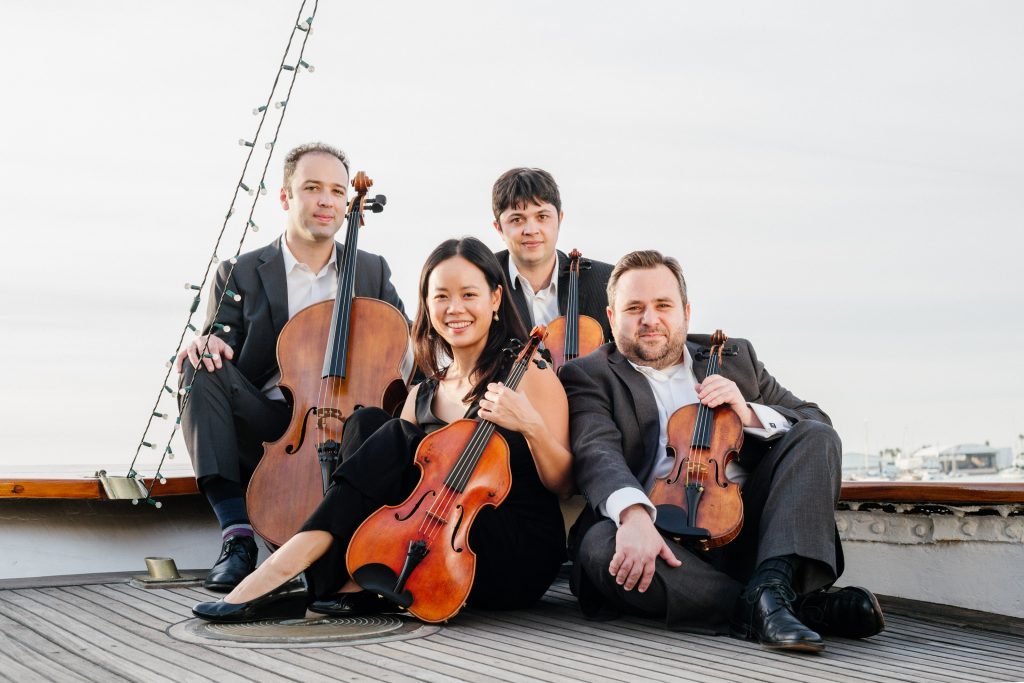The Hausmann Quartet’s Haydn Voyages Discovers Tomeka Reid’s Jazz Inspired Music
Although the Hausmann Quartet’s Haydn Voyages concert Sunday was titled Then & Now, the program was mostly then and very little now. Joining the requisite pair of Haydn string quartets that define this project, Hausmann played works by Henry Purcell and Felix Mendelssohn.

Hausmann Quartet: (from left) Alex Greenbaum, Angela Choong, Isaac Allen, Bram Goldstein [photo (c.) Samantha Zauscher]
The Chicago-based Reid calls herself cellist, composer, and improvisor, and jazz is her lingua franca. In 2013 she founded the Chicago Jazz String Summit, and her cultivation of jazz-inspired chamber music led to a MacArthur Foundation “Genius” Grant in 2022. Her infectious Prospective Dwellers begins with all four string players thrashing rapid pizzicato figurations that soon transform into smooth bowed themes. While violist Angela Choong intoned a languid melody that she passed on to first violinist Isaac Allen, cellist Alex Greenbaum supported them with an agitated, assertive bass line in a style that reflects the composer’s own improvisatory approach to the instrument. The piece was over all too soon, but I do hope Hausmann will bring more Tomeka Reid to the series.
Musicologist Derek Katz, the Haydn Voyages’ astute resident commentator, gave a short sermon decrying the tendency to classify every composer’s works into the three trite “early, middle, and late” periods. I nodded passively when he made his argument, but I still think it is helpful to observe that Hausmann’s program-opening Haydn Quartet in C Major, Op. 9, No. 1, is one of the composer’s earliest full-fledged string quartets, while the program’s second Haydn String Quartet—Op. 71, No. 3 in E-flat Major—comes from his late, mature period when he traveled to perform in London at his career’s apex.
Haydn’s Opus 9 quartet sports a relaxed, mellifluous character, offering a gentle, lilting Menuetto and a lithe solo in the Adagio that Isaac Allen played with touching affection. The Op. 71 Quartet not only overflows with bustling ideas set in more complex textures, but Haydn orchestrates his themes in more varied, sophisticated ways. I think we can safely say that Haydn learned quite a bit about the craft of composing chamber music between Opus 9 and Opus 71!
It was pleasurable to hear Henry Purcell’s Fantasia No. 8 in 4 Parts, Z. 739, between the two Haydn string quartets. Purcell lived almost a century before the string quartet flowered, and this charming Fantasia was written for a consort of viols, a family of early stringed instruments similar to but more delicate sounding than the instruments of the violin family. Hausmann gave a thoughtful account of Purcell’s well-crafted contrapuntal exercise, and the quartet gracefully communicated the Fantasia’s brisk fughetta and jovial concluding Presto.
In the outer movements of Felix Mendelssohn’s Quartet No. 3 in D Major, Op. 44, No. 1, Hausmann expressed a thrilling joie de vivre, especially the Molto allegro vivace, supported by the ensemble’s richest sonority and cleanest ensemble playing heard at this afternoon concert given at the Maritime Museum of San Diego.
This program was presented by The Hausmann Quartet on Sunday, February 26, 2023, on the upper deck of The Berkeley at the Maritime Museum of San Diego.
